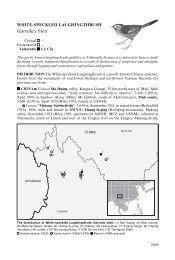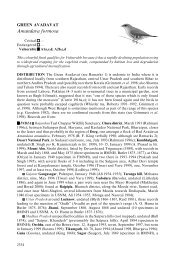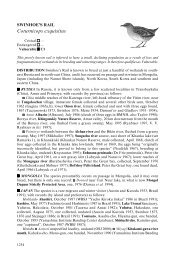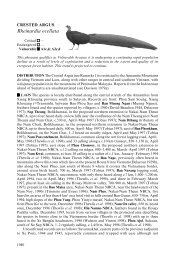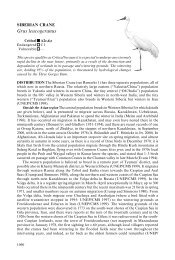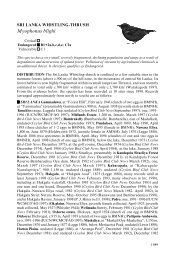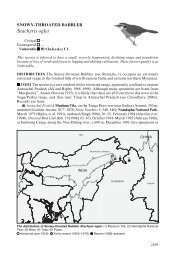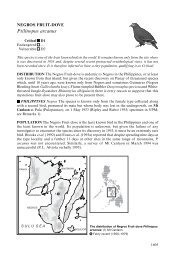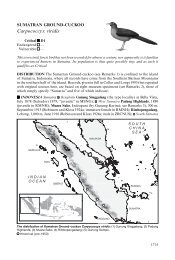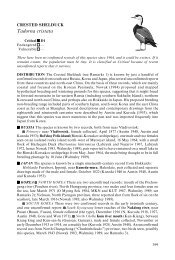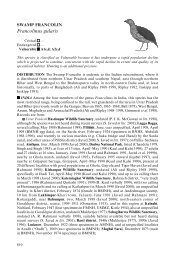Gyps bengalensis - BirdBase
Gyps bengalensis - BirdBase
Gyps bengalensis - BirdBase
Create successful ePaper yourself
Turn your PDF publications into a flip-book with our unique Google optimized e-Paper software.
<strong>Gyps</strong> <strong>bengalensis</strong><br />
120 in 1996, 130 in 1997, 80 in 1998, 82 in 1999 and 30 in 2000; and above Kangra fort in the<br />
lower Kangra district the number of the species sighted was c.100 in January 1997, 50 in<br />
January 1999, and eight in January 2001 (J. W. den Besten in litt. 2001). These figures cannot<br />
be regarded as statistically robust, of course, but they conform to the known trend;<br />
nevertheless, on the same three-day journey in January 2001 that the eight birds were seen at<br />
Kangra fort, White-rumped Vultures were seen on eight other occasions, totalling 31 + 8 =<br />
39 birds (J. W. den Besten in litt. 2001), a moderately encouraging number.<br />
Punjab Since the 1960s it was reported to be spreading into desert areas owing to increasing<br />
settlement and agricultural development (Ali and Ripley 1968–1998, Grubh 1983).<br />
Haryana This species was a very common breeder at Kalesar Wildlife Sanctuary (Kalsi<br />
1998a), and up to 650 vultures (mainly this species) were seen at a tannery in Ambala during<br />
1980–1981 (Ali and Grubh 1984). Indeed, it used to breed “very extensively” in the state, but<br />
in 1999 and 2000, despite journeys almost every Sunday covering 100–180 km, not a single<br />
White-rumped or “Long-billed” Vulture was seen (S. C. Sharma in litt. 2000).<br />
Delhi In the early 1970s, about 400 pairs of vulture (mostly this species), equating to a<br />
breeding density of 2.7 pairs per km 2 , were recorded in the north-western part of Old Delhi,<br />
mostly in mango gardens, and also along the Yamuna river (Galushin 1971); “large<br />
populations” of this species were found 10–20 years ago in the city (Satheesan 1999). A total<br />
of 4,500 vultures (mainly this species) were found at 24 carcass-skinning centres in Delhi in<br />
the early 1980s; an average of 2,045 individuals (maximum 4,000) were seen at Timarpur,<br />
Delhi, during December 1981–July 1982, but only 612 were seen on average (maximum 1,500)<br />
in the six months following closure of the landfill facility at this site in July 1982 (Ali and<br />
Grubh 1984); and 3,000 vultures (mainly this species) used to frequent a bone mill at Dasna,<br />
Delhi, until it was closed down in the early 1980s (Ali and Grubh 1984). The area between<br />
Delhi, Agra (Uttar Pradesh) and Bharatpur (Keoladeo National Park, Rajasthan) was<br />
estimated to hold about 15,000 White-rumped Vultures in 1990, but only about 50 were<br />
estimated to remain in 2000 (Satheesan 2000c); however, given that the same author found<br />
28 apparently healthy individuals at India Gate, New Delhi, in April 2000, and 35 at Najaf<br />
Khan Tomb, New Delhi, in May 2000 (Satheesan 2000c), the number of remaining individuals<br />
in mid-2000 may have been somewhat larger this estimate.<br />
Uttar Pradesh The species was listed as a fairly common breeder at New Forest, Dehra<br />
Dun (Mohan 1996), it was the commonest vulture of the lower Garwhal region, with flocks<br />
of over 90 in the Doon (Dun) valley (Singh 2000), and it probably also accounts for the<br />
flocks of 200 vultures recorded by George (1962) in the same region (Singh 2000), where it<br />
has been recorded up to 2,150 m (Lavkumar 1956a). It was regarded as abundant in Rajaji<br />
National Park (Pandey et al. 1994), and at least some birds were still present in 1999 (per S.<br />
M. Satheesan in litt. 2000), with 39 there in May 2000 (Rao 2000); as many as 50–100 were<br />
counted on a journey from New Delhi to Corbett National Park, and inside the latter, in<br />
1999 (per S. M. Satheesan in litt. 2000); “large populations” were found 10–20 years ago in<br />
the city of Bareilly (Satheesan 1999); it was a “very common” resident in Lucknow (Jesse<br />
1902–1903), breeding there in colonies of up to 60 nests (Reid 1881); it was a common breeder<br />
at Dudwa National Park (Javed and Rahmani 1998); it was very common in Gorakhpur<br />
district (Osmaston 1913); about 3,000 vultures (mainly this species) were found at a<br />
slaughterhouse in Basai, Agra, in the early 1980s (Ali and Grubh 1984; also Satheesan 1988);<br />
and 500–2,000 were found at Hapur, near Delhi, around the same time (Ali and Grubh<br />
1984). However, only 35 were found near Hapur in January 1998 in an area where this species<br />
was “seen in thousands a couple of years ago” (Prakash and Rahmani 2000).<br />
Rajasthan This species was once very common around Mt Abu (Butler 1875–1877); “large<br />
numbers” were found in 1965–1966 at Bhadasia, Kaga, Udaimandir and elsewhere around<br />
Jodhpur (Sharma 1970), large populations remained at least at Jodhpur 10–20 years ago<br />
(Satheesan 1999); and it was a fairly common resident breeder in Sariska Tiger Reserve<br />
597



